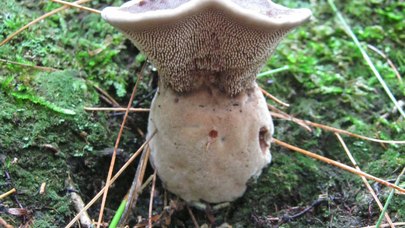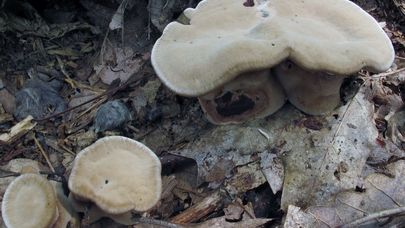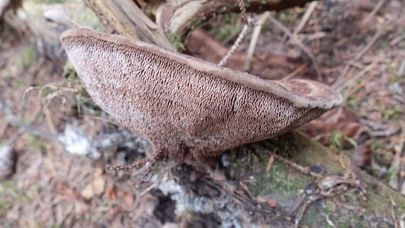Hydnellum spongiosipes
Description
Hydnellum spongiosipes is an inedible tooth fungus in the family Bankeraceae. Distinguishing features for Hydnellum spongiosipes include the brownish "teeth" on the underside of the cap, which bruise darker brown; the brown, velvety cap surface; the "duplex" flesh (with a soft, spongy layer and a harder, dark layer beneath it); the convex cap that becomes flat with age but not, typically, depressed or vase-shaped; and the spongy, swollen stem that gives the species its Latin name. Hydnellum spongiosipes grow under oaks east of the Rocky Mountains.
This is a mycorrhizal species associated with broadleaf trees. It is one of the “tooth” fungi so-called as they produce spores on spines on the underside of the cap instead of gills. It is found in Europe and North America. In Switzerland, it is considered a vulnerable species.
The spines can also have a velvet color when young and also darken with age.
Common names: Velvet Tooth, Spongy-footed Tooth..
Mushroom Identification
Ecology
Mycorrhizal with oaks (especially white oak) and other hardwoods; growing alone or gregariously; summer and fall; widely distributed east of the Rocky Mountains.
Cap
Single or fused with other caps; 2-10 cm wide; convex, becoming broadly convex to flat; cinnamon brown to dark brown; velvety; sometimes rugged or pitted; paler areas bruising dark brown.
Undersurface
Running down the stem; covered with crowded spines that are 4-7 mm long; pale to lilac brown; sometimes bruising dark brown; darker brown in age.
Stem
3-10 cm long; 1-3 cm thick at apex; club-shaped; swollen and much thicker below; spongy; dark brown; velvety.
Flesh
Upper layer pale brown and fairly soft; lower layer dark brown to purplish brown and corky.
Odor and Taste
Odor mealy or not distinctive; taste mealy or mild.
Chemical Reactions
KOH on flesh olive green to blackish or slowly black.
Spore Print
Brown.
Microscopic Features
Spores 4.5-7 x 4-5.5 µ; subglobose or irregular; prominently tuberculate. Clamp connections are absent.
Similar Species
The corky, tough flesh distinguishes it from tooth fungi in the genera Hydnum, Sarcodon, or Bankera and the dark spines and spore print from Phellodon. Other species of Hydnellum have caps that are darker in color and usually have concentric zones or marked radial ridges extending from the center of the cap to the edge. H. spongiosipes has neither and the closest species is H. ferrugineum, but this occurs with pine. Old species of tooth fungi are notoriously difficult to identify and it is not worth trying to do so.
Synonyms
Hydnum spongiosipes Peck (1898)
Hydnellum nuttallii Banker (1906)
Hydnum nuttallii (Banker) Sacc. & Trotter (1912)
Hydnellum velutinum var. spongiosipes (Peck) Maas Geest. (1957)
Photo sources:
Photo 1 - Author: Hamilton (ham) (CC BY-SA 3.0)
Photo 2 - Author: Erlon Bailey (CC BY-SA 4.0)
Photo 3 - Author: mycowalt (CC BY-SA 4.0)
Photo 4 - Author: pinonbistro (CC BY-SA 4.0)




